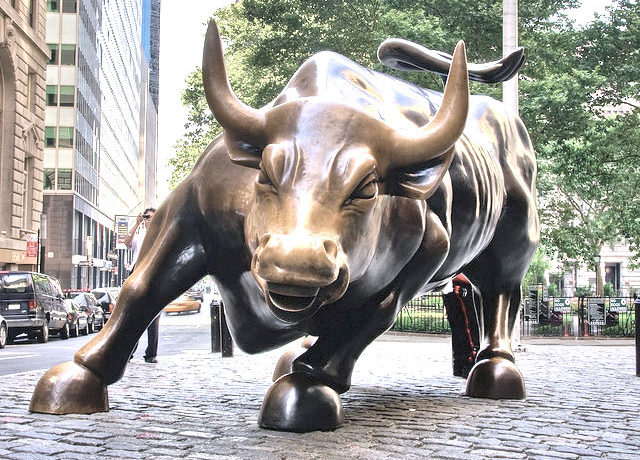If you were to look at our 1-year results, you would probably never guess this past year was such a violent ride. The S&P 500 was down -6.9%, and we are pleased to report our client portfolios were up between 9.4% and 20.1%, depending on the strategy. However, it would be an understatement to say our clients rode a steep rollercoaster along the way. This highlights the importance of focusing on longer term results.
The rally that began in March of this year continued into the third quarter with the S&P 500 up 15.6%, nearly the exact same amount it was up in the second quarter. This market is plowing forward under the general consensus that the economy has bottomed and we have entered the recovery phase. Despite the rosy picture being painted by everyone, our general outlook has remained unchanged. It’s difficult to argue a V-shaped recovery when the very two things that typically lead a recovery are in dire conditions, namely, taking on debt and consumer spending. The higher this market climbs, the more cautious we become.
Recession Near End?
Back in August, I was eating at a sandwich shop around the corner. As I walked in, posted against a tack board was the front cover of a local newspaper. In big, bold letters it read, “Fed says: Recession Near End.” I do not mean to be cynical, but I had to chuckle a little. It was this same Fed that, in November 2007, forecasted positive growth for 2008. We do not give much credence to their statement.
Even if statistics come out over the next few quarters, or even a year, that we are out of the recession, we believe it’s an illusion on paper. Sure, if you borrow and begin to spend some trillion dollars, you can expect the appearance of increased economic output, but this does not mean its actual, sustainable growth. Once you strip out government stimulus, the underlying economy continues to deteriorate.
Our biggest concern lies with debt burdens – both for the consumer and the government. On our website, in a July 14th blog titled “The National Debt Road Trip,” we discuss government debt in more detail – it is truly jaw dropping. We have previously compared leverage to drugs. Whenever we suffer economic pain, we seem to think the solution is to prescribe more drugs. This may give us a temporary, artificial fix to alleviate our symptoms, but the old problems will quickly resurface. The injection will wear off, and we can only do so many injections before experiencing severe withdrawal because soon, we won’t have any more injections left (unable to borrow). Eventually, we’ll need to experience a true withdrawal, go to “rehab,” and quit our addiction to debt in order to experience real growth. The longer we wait to go to “rehab,” the more difficult the withdrawal process will be.
Not only is earnings growth illusionary because it’s coming from borrowed money, but additionally, let’s think about a main driver of this recent rally – companies beating earnings expectations. These earnings surprises are a result of analysts ferociously chopping forecasts and are due to cost cutting, not due to the revenue line increasing. And most cost cutting is not coming from more efficient processes, but coming from layoffs which circles back to the unemployment problem.
If data ends up showing we are out of this recession, then we believe eventually we will be right back in. This is commonly referred to as a double-dip recession – we instead call it the same recession we began with, masked by a temporary drug-induced high.
At these price levels, the stock market is not allowing any room for error. The economy is still struggling and facing some pretty big demons. Is the recession over? For now, we remain a doubting Thomas – we’ll believe it when we see it.
A Shift to Quality
In BusinessWeek, Ben Levisohn wrote, “The stock market has gained 58% since its bear-market low Mar. 9, but the rally hasn’t lifted all equities equally. As is typical in many market bouncebacks, the worst recovered first. Low-quality companies, those with weak or nonexistent profits, mediocre return on equity, and less-than-stellar balance sheets, outpaced their more solidly profitable peers by nearly a 2-to-1 margin, according to research from Baird Private Wealth Management. Baird found that companies not earning a profit gained 92% from the Mar. 9 lows through the end of August, compared with a 47% rise for companies that had the highest profit margins” (September 16, 2009).
No doubt this has been a junk rally. Investors have rushed into economically sensitive stocks as their appetite for risk increased. In March, everyone seemed afraid of losing more money, now they seem afraid of missing out on a further rally.
We are taking this opportunity to shift to quality. Not only does a dismal picture for the economy lead us to favor the high quality, multi-national corporations, but even more, these stocks have lagged or are even negative for the year despite the huge run up in the broader market. We have been moving out of names like American Express, AmeriCredit, CarMax, Home Depot, Liberty Interactive, and Target, and shifting the proceeds to higher quality names such as Pepsico, Procter & Gamble, Coca-Cola, Johnson & Johnson, Pfizer, and Wal-Mart. Whether the rally continues to run up or if there will be another significant pull back is anyone’s guess, but we believe in either scenario, these are the type of companies that offer the best values and potential upside, as well as the best downside protection during the next few unpredictable years.
May Buy-and-Hold R.I.P.?
In the early part of the 20th century, the average mutual fund turnover was in the range of 20% to 10%, meaning the average holding period of a stock was 5 to 10 years. This turnover has increased to over 100% (meaning a completely different portfolio every year), and spiked even further last year. There are many reasons for this, but in large part, it’s because over the years, investors have increasingly become short-term oriented. In 2006, USA Today cited a survey conducted by Retirement Corp. of America wherein they asked 1000 individual investors “How long are you willing to wait before moving your money from a poorly performing investment?” More than 60% responded less than a year!
An onslaught of news articles have questioned buy-and-hold investing – a concept misunderstood. One argument has been if you were forced to liquidate (perhaps you were entering into retirement, for example) during a crash such as this past year, time actually became your enemy. I agree – time can go to your detriment. While time can provide an opportunity to recover from a drop in prices, on the other hand, it also gives you more time to encounter a market crash. As Keynes put it, “The market can stay irrational longer than you can stay solvent.” But this point is irrelevant – buy-and-hold was never meant to imply that the longer you hold stocks, the risk of selling at an inopportune time becomes eliminated.
The other argument goes something like this, “If I had bought the S&P 500 a decade ago, I would have gone nowhere.” But this fact does not discredit the notion of long-term investing. The problem with this logic is it never takes into account the number one underlying principle that led to the very concept of buy-and-hold, specifically, buying a security below its intrinsic value. If you buy an undervalued security, then you can hold it, wait, and regardless of short term price fluctuations, eventually the value will be recognized over time.
Thus, the key ingredient missing here is the price paid at entry point. Many have misunderstood the concept, incorrectly thinking it meant long-term returns were guaranteed if you simply owned stocks for a long enough time period, regardless of purchase price. It would be ridiculous to overpay for a security under the pretense that through the passage of time, the risk of buying an overvalued security goes away. In fact, that is precisely where risk steps in – overpaying for a security, no matter how good the business.
For example, despite their growth, the internet stocks that successfully survived the past decade but were purchased at the peak of the dot com era may never see those peak prices again. Buy-and-hold simply makes no sense when a stock price jumps way ahead of its value. This is why the theory appears defunct. In general, people have been overpaying for stocks for over a decade.
However, we, and many other value minded investors, can humbly acknowledge that we have handily compounded money over the past decade by following basic value principles.
To clarify buy-and-hold, we like to extend the phrase to “buy-and-hold until price converges with value.” This is why long-term investors who understand the meaning of buy-and-hold have experienced more turnover this past year – the more volatility in the markets, the larger the disconnect between business value and stock price. Nevertheless, true value investors remain long-term thinkers.
The concept of buy-and-hold stands strong under the assumption that you buy at a margin of safety. Therefore, do not give into the campaign touting that long-term investing is dead. In fact, ironically, the best time to buy-and-hold the market is likely when there is much negativism about the concept, and the best time to get out is likely when everyone praises the notion!
Concluding Remarks
We hope our comments have not misled you to believe we are pessimists, but rather realists. If you recall, our first client letter was titled, “If ye are prepared, ye shall not fear.” At that time, we were very concerned about the macroeconomic environment before we witnessed the precipitous drop. However, we were prepared, and our clients have benefited, while many others have seen their portfolios significantly decline. Once again, today we are citing concerns. But we are very optimistic about the individual holdings within our portfolios. Many quality companies are selling at very low valuations. Whether the market marches forward, or retreats, we believe these companies represent the best values today and are at prices that will deliver strong returns over the long term. This past year we witnessed a strong diversion of prices and business value, but these gyrations are precisely what afforded us great opportunities. We believe that this high volatility will continue as investors cheer any ounce of news that lends itself to economic improvement, and flee in fear at anything that indicates otherwise. Through all this, we stand ready to act on the opportunities that surface.
Sincerely,
The YCG Team
Disclaimer: The specific securities identified and discussed should not be considered a recommendation to purchase or sell any particular security nor were they selected based on profitability. Rather, this commentary is presented solely for the purpose of illustrating YCG’s investment approach. These commentaries contain our views and opinions at the time such commentaries were written and are subject to change thereafter. The securities discussed do not necessarily reflect current recommendations nor do they represent an account’s entire portfolio and in the aggregate may represent only a small percentage of an account’s portfolio holdings. A complete list of all securities recommended for the immediately preceding year is available upon request. These commentaries may include “forward looking statements” which may or may not be accurate in the long-term. It should not be assumed that any of the securities transactions or holdings discussed were or will prove to be profitable. S&P stands for Standard & Poor’s. All S&P data is provided “as is.” In no event, shall S&P, its affiliates or any S&P data provider have any liability of any kind in connection with the S&P data. MSCI stands for Morgan Stanley Capital International. All MSCI data is provided “as is.” In no event, shall MSCI, its affiliates or any MSCI data provider have any liability of any kind in connection with the MSCI data. Past performance is no guarantee of future results.




